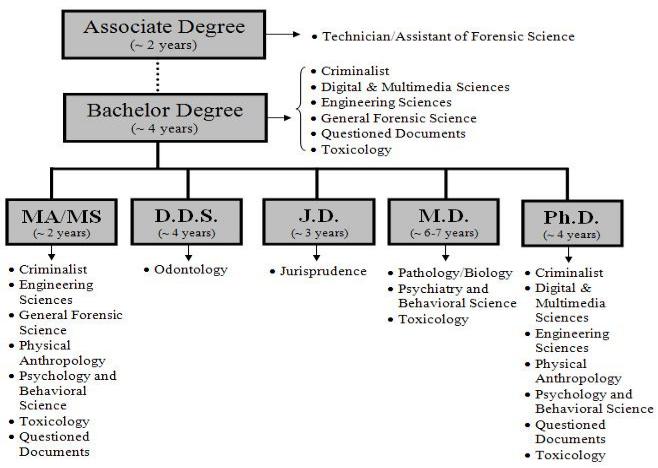
Английскй учебник
.pdf
D.D.S – Doctor of Dental Surgery
MA – Master of Arts
MS - Master of Sciences
J.D. – Doctor of Jurisprudence (the USA)
M.D. – Doctor of Medicine
Ph.D. – Doctor of Philosophy
4. % & !!, & .
1.A.D. - ____________________
2.B.C. - _____________________
3.C.I.D. - ____________________
4.M.P. - _____________________
5.P.S. - ______________________
6.U.K. - ______________________
7.G.C.E. - ____________________
5. 0 #, -
! ! , & ( & -
$#.
Dear Sir,
I/be/ present/student/final year/secondary school/Moscow/Russia.
1. __________________________________________________________________
253


A forensic generalist is a particular kind of forensic scientist who is broadly trained in a variety of forensic specialties. They are big picture people who can help reconstruct a crime from work performed with the assistance of other forensic scientists, and then direct investigators to forensic specialists as needed. They can also make for good crime lab administrators or directors.
Because of the depth and complexity of criminalistics, the need for specialists is inescapable. There can be serious problems, however, with overspecialization. Persons who have working knowledge of a broad range of criminalistics problems and techniques are also necessary. These people are called generalists. The value of generalists lies in their ability to look at all of the aspects of a complex case and decide what needs to be done, which specialists should be involved, and in which order to carry out the required examinations.
The generalist typically has broad education and training in the major forensic sciences, and will often have a master's or doctorate level education. However, many of those claiming to be generalists have only a law enforcement background with no formal science education. These are often police technicians who have confused their role with that of forensic scientist.
As suggested, a related profession is that of evidence technician. An evidence technician is charged with the recognition, documentation, collection, and preservation of physical evidence. Sometimes they even have training, though this is not necessary. A full time evidence technician is typically not a forensic scientist, and is not necessarily qualified to examine forensic evidence and interpret its meaning. Evidence technicians may be attached to the police department, the crime lab, or the medical examiners office. They are not necessarily sworn police officers, though they can be. It is common for technicians not to have attended a four-year degree program at a college or university. Some have two year associates degrees, and still others have only on the job training with a high-school diploma. In many jurisdictions, police officers must do this work themselves with little or no forensic training, for lack of specialized assistance.
7. .
1. to give expert testimony |
a. ) # |
||
2. to provide interpretations under oath |
b. |
||
|
|
|
|
3. to testify to their findings |
c. $ |
|
$ - |
|
|
|
|
4. on behalf of the law |
d. $ % |
||
|
|
||
5. just resolution of conflict |
e. $ |
||
|
|
||
6. the outcome of the examination |
f. $ $ $ % |
||
|
|
|
|
7. to be trained in crime reconstruction |
g. |
|
|
|
|
||
8. big picture people |
h. $ - " |
||
|
|
|
|
9. to have law enforcement background |
i. $ |
% |
|
|
|
||
10. to be charged with documentation |
j. $ - |
||
and collection of physical evidence |
|
|
|
11. preservation of physical evidence |
k. $ |
||
|
|
|
|
12. a high-school diploma |
l. |
|
|
|
$ |
||
|
|
|
|
8. !$ $ ,
! , ! !, !
!.
256

PROFESSIONAL SKILLS
Critical thinking (quantitative reasoning and problem solving).
Decision-making.
Good laboratory practices.
Awareness of laboratory safety.
Observation and attention to detail.
Computer proficiency.
Interpersonal skills.
Public speaking.
Oral and written communication.
Time management.
Prioritization of tasks.
10..
1. |
– % " ) |
. |
|
2. |
2$ " % " " - |
||
|
# . |
|
|
3. |
% |
$ & $ |
& - |
|
. |
|
|
4. |
% |
(is concerned) " & - |
|
, ) .
5.%, % -
$ , #$ $ " # %-.
6.% $ $ $ % .
11. . .
TEXT
(Title)_________________________________________________
1._________________________________________________________________________
2. ________________________________________________________________________
a)_____________________________________________________________
b)_____________________________________________________________
c)_____________________________________________________________
3._________________________________________________________________________
a)______________________________________________________________
b)______________________________________________________________
Forensic science is a multidisciplinary subject used for examining crime scenes and gathering evidence to be used in prosecution of offenders in a court of law. Forensic science techniques are also used to examine compliance with international agreements regarding weapons of mass destruction.
The main areas used in forensic science are biology, chemistry, and medicine, although the science also includes the use of physics, computer science, geology, and psychology. Forensic scientists examine objects, substances (including blood or drug samples), chemicals (paints, explo-
258

